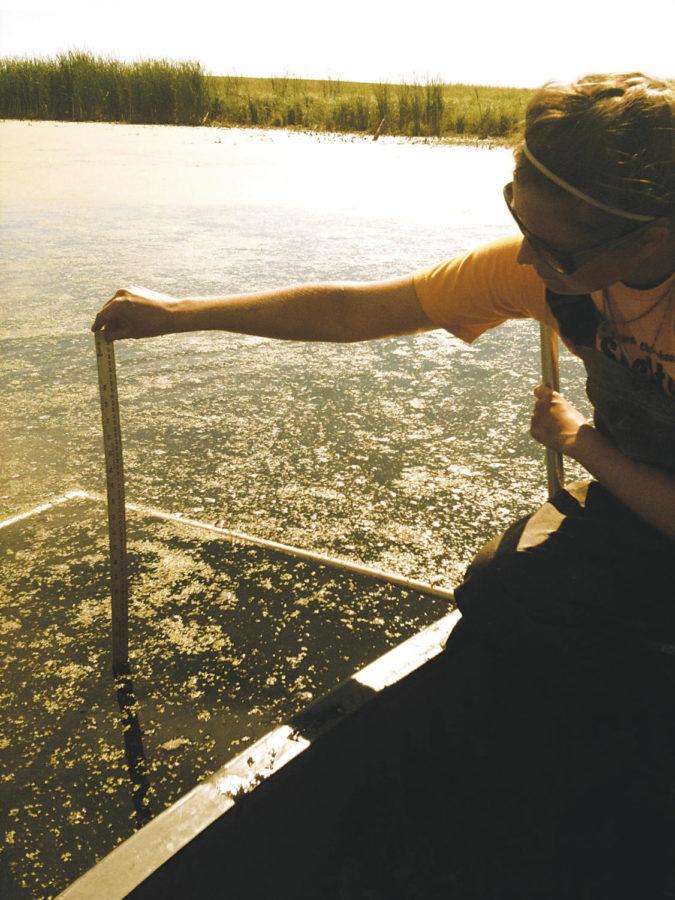Importance of Iowa wetlands not to be overlooked
Courtesy photo: Kristine Maurer
Kristine Maurer samples aquatic vegetation to identify the species and their percent cover.
November 4, 2010
With the major flooding that occurred at Iowa State this summer, Timothy Stewart, professor of natural resource ecology and management, and Kristine Maurer, graduate in natural resource ecology and management, are making it their mission to advocate the importance of Iowa wetlands.
The pair has been conducting research to find indicators for healthy wetlands, and then plans to give the data to Iowa Department of Natural Resources and other environmental agencies.
“These wetlands are a method of natural flood control,” Stewart said. “Essentially, rain falls on the landscape or snow melts, and as it flows off the landscape, it can go into these wetlands and essentially be held there, preventing rapid flow to the streams. And when we have these rapid inputs of water in these streams, we have flood problems.”
Wetlands are beneficial for retaining soil and preventing soil erosion, he said. They provide habitats for various endangered species along with other waterfowl, mammals and several invertebrates.
“There’s about 20 endangered species that the DNR has listed that use wetlands as their habitats,” Maurer said.
Wetlands function as natural filters, absorbing nutrients and other substances to provide sanitary drinking water.
“They have some regional control over things like climate, because when you used to have millions of these depressions, they were always evaporating water during the summer, and that will eventually lead to local thunderstorms to recycle the water,” said Arnold van der Valk, professor of ecology, evolution and organismal biology.
Plants, Stewart said, are essential for the survival of wetlands.
“Plants contribute to retention of nutrients, sediment and water in wetlands and keeping [water] from going into streams too quickly or at all by absorbing nutrients, retaining them in their tissues and also by anchoring the sediments and keeping them in place in the wetlands,” Stewart said.
“Plants tend to provide habitat refuges for invertebrates,” Maurer said, “and also have a tendency to reduce re-sedimentation, so they keep the water calm and clear just by keeping sediments settled, and invertebrates are really awesome at eating phytoplankton and keeping those abundances down,” Maurer said.
Determining the functions of these wetlands and how they interact is the intent of the study, along with developing a set of variables they can refer to if they were to routinely monitor and access the wetlands, Stewart said.
“We’re looking at community composition of biotic variables, such as vertebrates, plants and invertebrates, and we’re also looking at physio-chemical variables like level of oxygen, pH temperature and landscape variables. Based on the relationships that we see from those variables we’re hoping to determine which of those variables are most important,” Maurer said.
The researchers are also interested with the effects pollutants could have on wetlands, including substances like herbicides and the possible impact it would have from one ecosystem to the next.
Besides healthy variables, some afflicting variables exist, and one of them is fish.
“We you have large-bodied fishes, you have fewer plants, lower invertebrate diversity, [and] you have lower water clarity,” Stewart said. “In other words, turbid situations — cloudy water.”
Fish excrete nutrients when they ingest invertebrates, which emits phosphorous and nitrogen, two nutrients responsible for algal blooms [algae] that cause water quality problems. Because of their size, large fishes will feed on the bottom, which re-suspends the soil in the water.
“They feed on the bottom of the wetland and so they’ll stir up the sediments just because they’re looking for food and they’re moving around, burrowing and stuff like that,” Maurer said.
Drainage tiles that farmers would use for agricultural systems have a tendency to connect wetlands to things that they were previously connected to or things that they’re not supposed to be connected to. This can lead to fish migrations and invasions of wetlands they don’t belong in, Maurer said.
“All of the wetlands are connected to the rivers now by these sub-surface drainage ditches, so the fish can actually move up into these drainage ditches and they move into these wetlands,” van der Valk said.
“Fishes have a place in lakes, streams and rivers — they don’t have a place in prairie pothole regions and most wetlands,” Stewart said.







